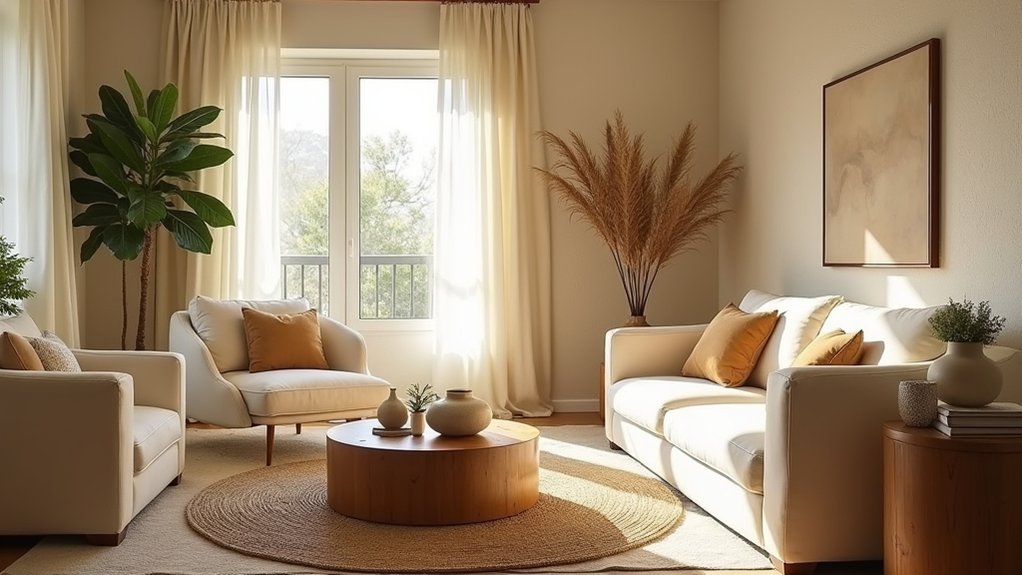
14 Beige Living Room Wall Ideas That Keep Things Light and Inviting
Beige living room walls create a serene foundation that stays bright when paired with varied textures and tones. Mixing woven jute rugs, soft cushions, and wood accents adds both warmth and layered depth. Painting a taupe border modernizes the look, while black or butterscotch leather accents bring sophisticated contrast. Layering different beige shades, incorporating natural stone, and strategically placed pops of blue or red all enhance visual interest. Additional expert tips can further raise this inviting palette.
Key Takeaways
- Layer multiple shades of beige and taupe to add depth and keep the living room light yet visually interesting.
- Incorporate natural textures like jute rugs, stone accents, and wood for warmth and tactile appeal against beige walls.
- Use butterscotch leather or earthy statement furniture as focal points to break up monotony and add inviting contrast.
- Add matte taupe beige painted borders to walls for a modern, structured look that enhances ceiling height and defines spaces.
- Introduce vibrant accents like red, blue, or black through décor and art to energize the space while maintaining a cohesive palette.
Add Texture for Depth and Warmth
A woven jute rug underfoot or a stone fireplace surround introduces essential tactile variation to beige living rooms, preventing monotony and enhancing visual depth. Expert designers recommend an intentional interplay of texture to create a layered environment that feels both sophisticated and inviting. Integrating natural wood accents, plush rugs, and soft cushions adds dimensionality and warmth, encouraging relaxation. Textured wall treatments—such as a subtle coffee wash or matte finish—further enrich the beige palette without overpowering. Strategic layering, like draping a knitted throw over a neutral sofa or incorporating a patterned area rug, envelops the space in coziness. Combining smooth and rough surfaces guarantees the room avoids a flat, one-dimensional appearance, thereby achieving a harmonious, visually engaging, and comfortable living space. Aim for at least three distinct textures to create a trendy and artistically rich atmosphere while avoiding overwhelming the space.
Warm up a White Room With Beige Accents
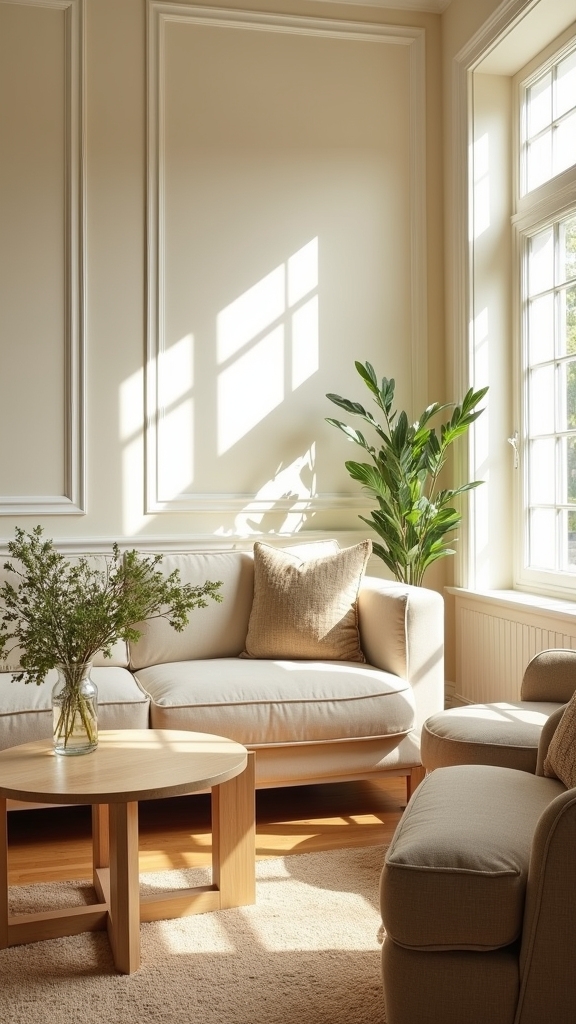
When white walls risk rendering a living space cold or clinical, the strategic introduction of pale beige accents effectively softens the atmosphere. Expert designers recommend layering beige textiles—such as throws, cushions, or area rugs—to impart warmth and tactile depth, mitigating any sense of sterility. Wall art in subtle beige or warm taupe tones can serve as visual anchors, drawing the eye and establishing a cozy atmosphere without overwhelming the minimalist appeal of white walls. In north-facing rooms, where natural light can appear cooler, these beige accents maximize brightness while fostering an inviting ambiance. Natural fabrics and sustainable options, such as wood, linen, and cotton, enhance the cozy feel while promoting eco-friendly decor choices. The neutral synergy between beige accents and white walls also forms a versatile foundation, allowing effortless adaptation to evolving decor trends or seasonal updates, ensuring enduring visual interest and comfort throughout the year.
Layer Multiple Shades of Beige
Layering multiple shades of beige, such as taupe and rust, introduces nuanced contrast and tactile warmth to living room walls. Scandinavian layering techniques emphasize subtle gradations and seamless shifts, enhancing both cohesion and serenity. This approach is especially effective in compact spaces, where tonal variety fosters depth and a welcoming, cocooning ambiance. Incorporating low-light and statement plants can further enrich the space by adding natural beauty and creating a calming atmosphere.
Mix Taupe and Rust
Subtle gradations of beige, anchored by taupe and accented with rust, generate a visually dynamic foundation for a living room. Layering multiple shades within a neutral space prevents the environment from appearing flat, while encouraging depth and a sense of enveloping comfort. Incorporating both taupe and rust, alongside softer beige tones, injects warmth and a sophisticated vibrancy. The following table illustrates practical pairings for visual and tactile variety:
| Wall Color | Accent Suggestion |
|---|---|
| Pale Taupe | Rust-toned cushions |
| Warm Beige | Textured throws |
| Deep Taupe | Brass lighting |
| Muted Rust | Linen drapes |
This approach is especially effective in compact living areas, where the interplay of warm hues and varied textures can make the space feel intimate and inviting while maintaining a refined aesthetic.
Scandinavian Layering Techniques
Drawing inspiration from Scandinavian design principles, the use of multiple beige tones—ranging from pale taupe to muted rust—establishes a visually cohesive and inviting backdrop for the living room.
This expert approach to beige walls leverages subtle gradations to foster depth, warmth, and sophistication. The neutral backdrop serves as a canvas for thoughtfully curated natural textures, enhancing both tactility and visual appeal.
To successfully layer beige in a Scandinavian style:
- Select three to four beige shades for walls, textiles, and furnishings, ensuring tonal harmony while retaining interest.
- Incorporate natural textures—such as oak, linen, and wool—to provide contrast and reinforce the organic, calming intent central to Scandinavian spaces.
- Balance simplicity with warmth by integrating minimal decor and layered neutrals, supporting a tranquil and inviting ambiance.
Cozy Small Space Ideas
Building upon the nuanced approach of Scandinavian layering, beige walls in small living rooms benefit from a thoughtful interplay of multiple tones. By employing a spectrum from pale taupe to deep rust, designers establish a cozy living room that exudes depth and warmth.
This method of layering beige shades introduces visual complexity, essential for neutral living room ideas that avoid monotony. Lighter beige on walls paired with deeper hues in furnishings creates spatial balance, ensuring the scheme remains dynamic rather than flat.
Soft textures—think plush throws, wool rugs, or linen drapery—further contribute to a warm beige living room, enhancing tactile comfort. Strategic shading also helps define functional zones, maximizing organization and flow in compact settings, while maintaining a harmonious and inviting aesthetic.
Go Deep With Rich Beige Tones
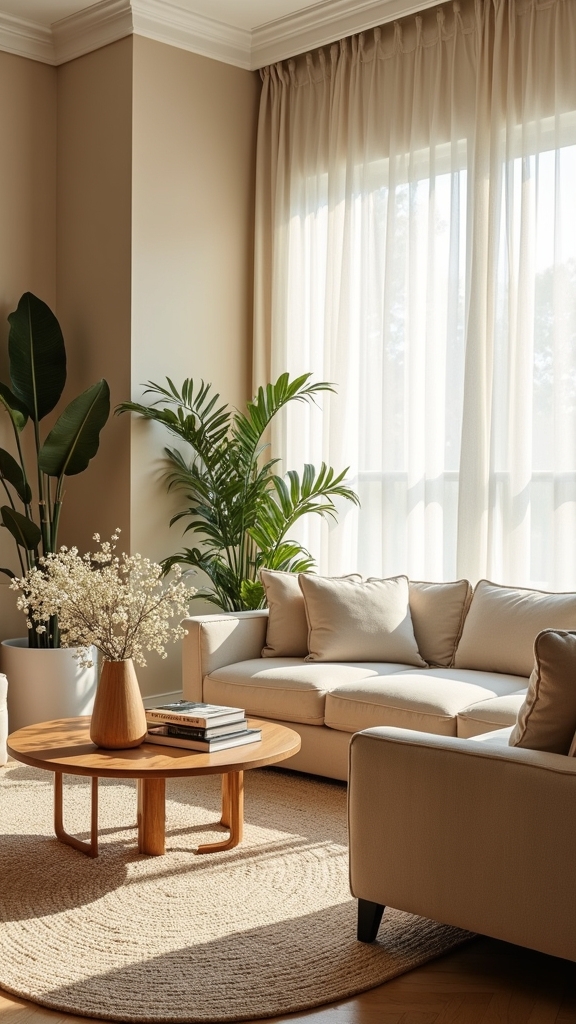
A canvas of rich honey-toned beige on living room walls establishes a soft, tranquil foundation that instantly enhances the atmosphere.
This nuanced approach to color envelops spaces in warmth, making even expansive rooms feel intimate and welcoming.
Rich beige tones pair seamlessly with plush furnishings in analogous shades, amplifying a sense of comfort without overwhelming visual harmony.
For those seeking a warm, inviting atmosphere in urban environments, deep beige walls offset industrial starkness and promote relaxation.
Layering cozy textiles such as velvet and faux fur can further enhance the inviting ambiance, creating a sophisticated and cozy atmosphere that complements the rich beige tones.
- Layer Textures: Introduce tactile interest with woven throws, velvet cushions, and natural fiber rugs in complementary hues.
- Vary Accents: Incorporate wood, metallic, or ceramic decor pieces to add dimension without detracting from the cohesive palette.
- Adapt Lighting: Employ warm, diffuse lighting to accentuate the depth and richness of the beige backdrop.
Paint a Beige Border for Visual Interest
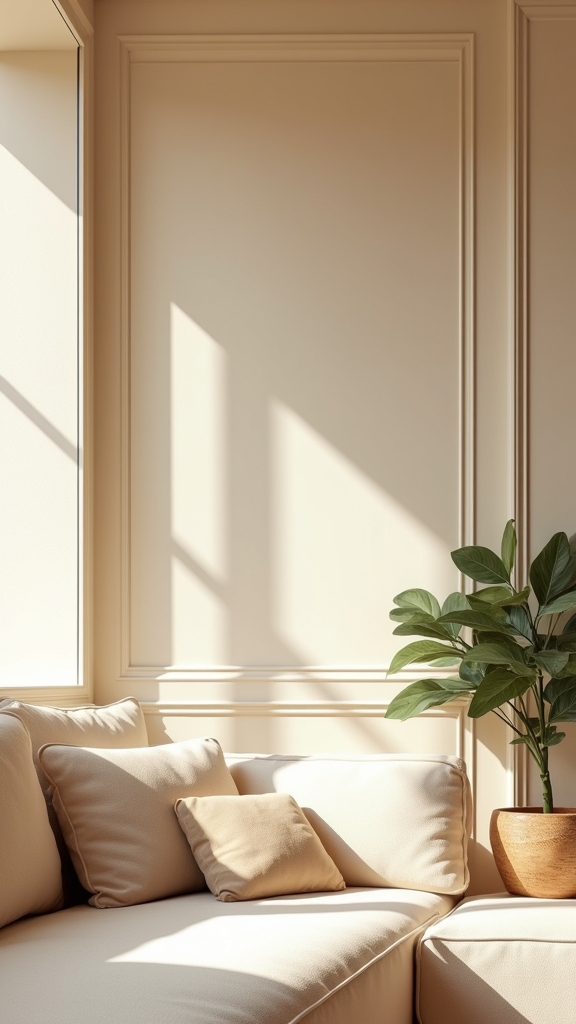
Introducing a taupe beige matte border along the walls can instantly modernize the living room by framing architectural elements and enhancing visual structure. This technique not only grounds the seating area but also creates an illusion of increased ceiling height, optimizing spatial perception. For a cohesive outcome, careful color selection and precise placement are essential to maximize both sophistication and functional zoning. Incorporating textured surfaces can further enhance the depth and interest of the space, merging both form and function in a modern design approach.
Enhancing Ceiling Height Illusion
When strategically applied, a matte taupe beige border painted around the room’s perimeter can visually anchor the seating area while simultaneously creating the illusion of greater ceiling height.
Utilizing beige paint in a slightly deeper hue than the main wall color enhances architectural interest, subtly drawing the eye upward and lending a sense of vertical expansion.
To achieve ideal effect, consider the following expert recommendations:
- Precision Placement: Position the border 6–12 inches below the ceiling line to maximize the vertical stretch and avoid crowding the crown molding.
- Contrast Selection: Choose a taupe beige that is distinct but harmonious with the primary wall shade to guarantee the border enhances, not overwhelms, the space.
- Matte Finish: Opt for a matte finish to prevent glare and emphasize the soft, inviting quality of the beige paint.
Grounding the Seating Area
By incorporating a matte taupe beige border around the seating area, designers achieve a grounded focal point that subtly delineates the social zone within the living room.
This approach to beige walls employs a strategic color frame, offering a visual anchor that enhances spatial definition without overpowering the existing décor. Grounding the seating area with a painted border not only creates interest, but also fosters an intimate, inviting atmosphere that encourages conversation and relaxation.
The matte finish prevents glare, maintaining a soft and sophisticated surface. This border technique also visually lifts the ceiling, contributing to an airy yet structured feel.
Modernizing Wall Design
How can a living room’s walls subtly shift from standard to striking? Painting a taupe beige matte border around beige walls is an expert technique that instantly modernizes wall design. This approach introduces depth and dimension, elevating the visual narrative of a modern living room.
With its understated yet sophisticated appeal, a beige border achieves several practical objectives:
- Spatial Enhancement: By outlining the perimeter, the border creates the illusion of taller ceilings, making compact spaces feel more expansive.
- Visual Organization: The border visually anchors furniture, delineating the seating area while enhancing the room’s overall structure.
- Versatile Aesthetics: Compatible with diverse decor styles, this treatment imbues beige walls with character while retaining a light, inviting atmosphere.
This method offers a refined, pragmatic update for contemporary interiors.
Use Sepia Tones for Timeless Appeal
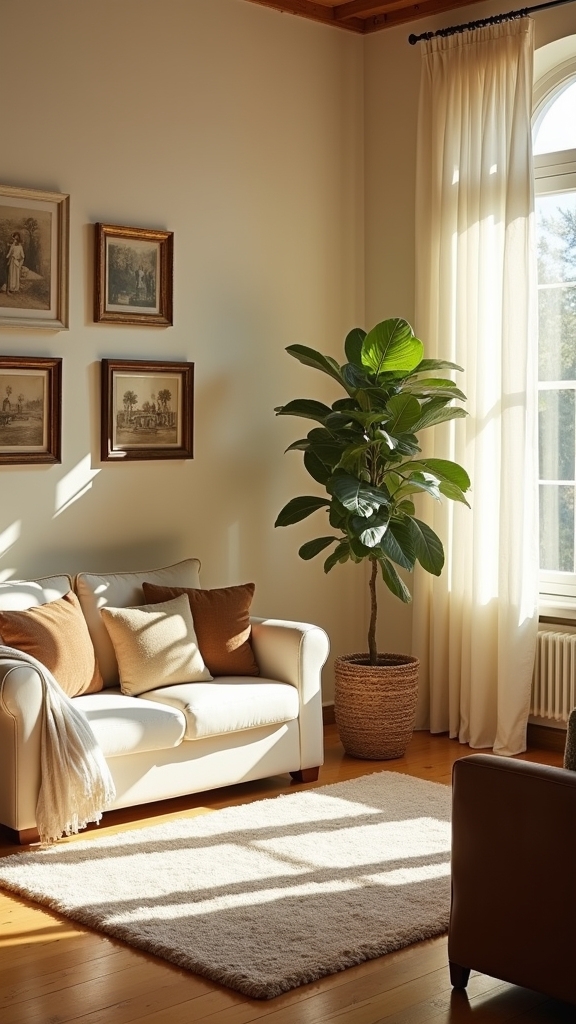
Sepia tones, defined by their warm, brownish hues, introduce a sense of timeless sophistication to beige living room walls. These nuanced shades serve as a bridge between classic and contemporary aesthetics, fostering visual depth while maintaining an inviting ambiance. In beige living rooms, layering multiple sepia tones—such as pairing a chocolate brown velvet sofa with subtly mottled walls—enhances the warmth and comfort of the space. This approach seamlessly integrates with warm color palettes, complementing earthy accents and rich textiles. Incorporating natural materials and houseplants further elevates the inviting atmosphere, adding a touch of greenery and organic texture that balances the sepia tones. The result is a grounded, cohesive environment that feels both elegant and homely. Designers recommend sepia tones for their versatility, allowing homeowners to refresh decor easily while preserving a classic character ideal for gatherings or tranquil retreats.
Wash It Out With Textured Wall Treatments
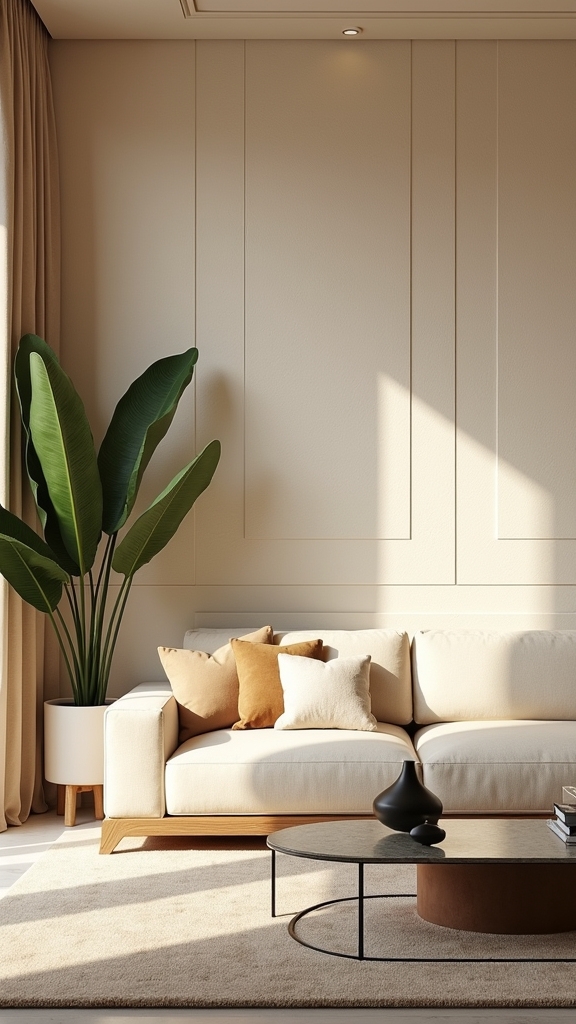
When subtlety is key, textured wall treatments—such as a coffee wash technique—offer an effective way to enrich beige living rooms with both warmth and visual intrigue. By layering translucent washes over beige walls, designers achieve a nuanced, lived-in appearance that enhances the cozy atmosphere without overwhelming the space. This approach diffuses natural and artificial light, softening reflections and contributing to a welcoming ambiance. Textured finishes are particularly suited to cottage-inspired interiors, where a relaxed, inviting environment is essential. For ideal results:
- Apply a diluted paint or glaze in sweeping motions to build dimension and avoid uniformity.
- Incorporate gentle brushwork or sponging for tactile interest and subtle pattern variation.
- Pair textured wall treatments with neutral furnishings to maintain balance and accentuate the room’s depth.
Adding decorative elements such as mouldings or floating shelves can further enhance the overall theme and create a cohesive design.
Warm up a Formal Space With Soft Beige
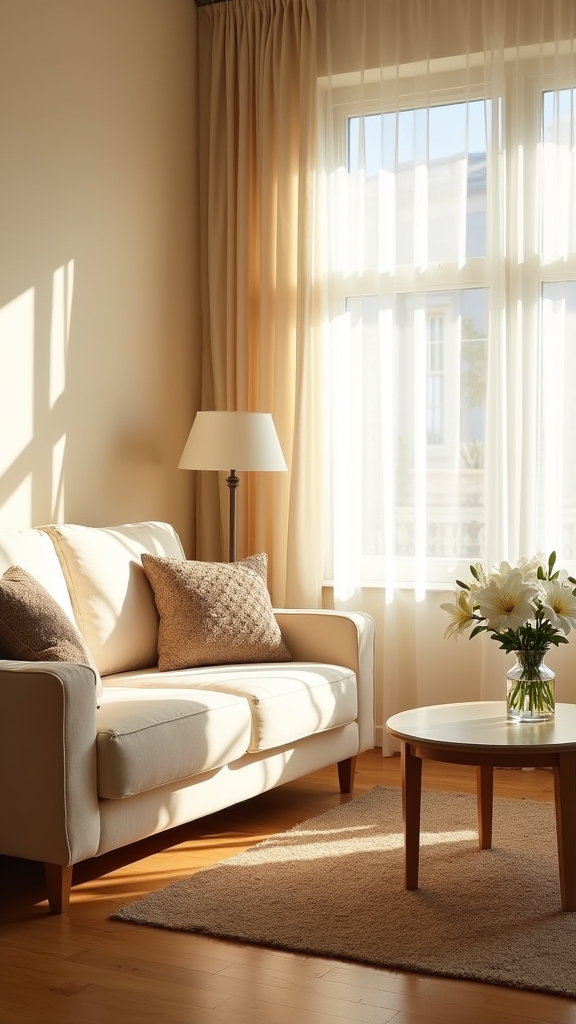
Though formal living rooms often evoke a sense of grandeur, introducing soft beige wall tones immediately tempers rigidity by infusing the space with warmth and subtle elegance. Beige walls act as a sophisticated canvas, allowing curated artwork and designer furnishings to command attention without competing with the backdrop. Selecting warm beige shades guarantees the environment feels both refined and inviting, promoting relaxation while preserving the room’s enhanced aesthetic. For ideal visual interest, designers recommend layering tactile accents such as plush textiles or subtly patterned rugs within the beige color scheme. This approach softens the angularity of contemporary furnishings and creates a cohesive, tranquil environment. Incorporating classic furniture and textiles can further enhance the timeless elegance and cozy ambiance of the living space. Ultimately, warm beige shades offer an inviting atmosphere that encourages guests to linger, balancing comfort with the luxurious undertones of a formal living space.
Use Desert-Inspired Hues for a Soothing Palette
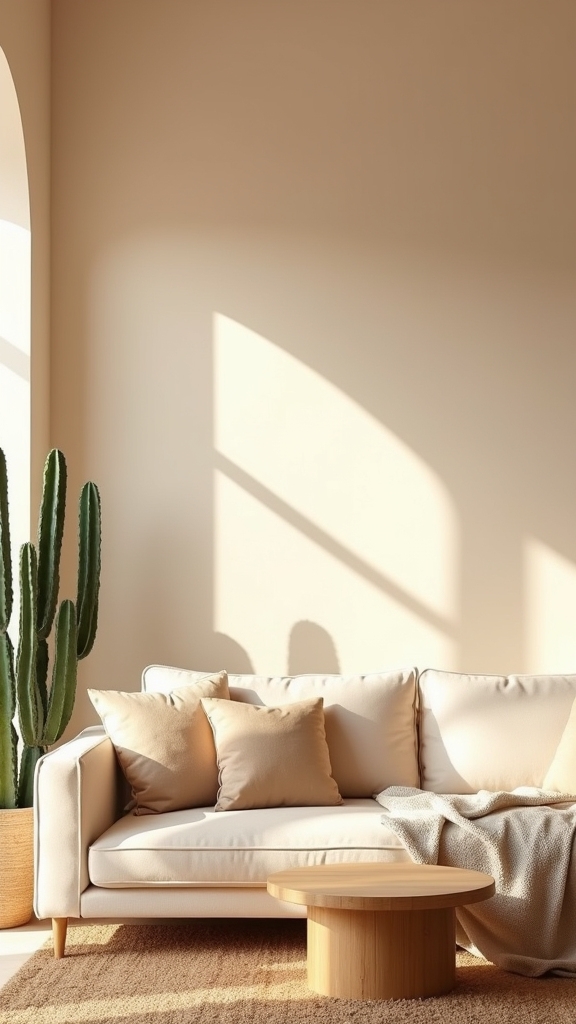
A palette anchored in sandy beige tones evokes the calm and warmth of desert vistas, fostering a serene living environment. Integrating butterscotch leather accents introduces tactile richness and visual contrast against neutral walls. This combination offers a practical foundation for layering textures while maintaining a cohesive, tranquil aesthetic. Adding warm yellows and mustard touches can enhance the cozy glow and ambiance of the room, creating an inviting atmosphere ideal for relaxation.
Embrace Sandy Beige Tones
Sandy beige tones, reminiscent of Southern California deserts, provide a tranquil foundation for living room design. These desert-inspired hues evoke a soothing environment, ideal for spaces seeking a relaxed yet sophisticated ambiance.
The nuanced warmth of sandy beige walls enhances natural light and harmonizes with organic textures, producing a cohesive and inviting look. Expert designers recommend the following strategies:
- Layer soft beige and off-white shades for visual depth while maintaining a unified, calming palette.
- Pair sandy beige walls with natural materials like wood, stone, or woven fibers to amplify tactile interest and connect interiors with the outdoors.
- Integrate indoor greenery to enliven the neutral background, bringing a sense of liveliness and reinforcing the connection to nature.
This approach delivers timeless versatility and understated elegance.
Butterscotch Leather Accents
Building upon the tranquil foundation of sandy beige walls, butterscotch leather accents introduce a layer of warmth and visual intrigue to the living room.
The rich, golden undertones of butterscotch leather offer a striking yet harmonious contrast against soft beige backgrounds, resulting in a warm and inviting atmosphere reminiscent of desert-inspired palettes.
Incorporating butterscotch leather through statement furniture—such as a sofa or armchair—adds both tactile luxury and visual depth without overpowering the space.
This color pairing facilitates seamless integration of additional earthy elements like natural wood or stone, enhancing the organic ambiance.
Strategically placed butterscotch accents can also serve as focal points, breaking the monotony of neutral walls while maintaining aesthetic cohesion and elevating the sophistication of the interior design scheme.
Accent With Reds and Blues for Vibrancy

Vibrant accents in red and blue inject energy and dimension into beige living room walls, transforming a neutral base into a visually engaging space. Expertly chosen accent colors introduce vibrant hues that balance beige’s subtlety, offering both visual excitement and a cozy feel.
Red and blue accents enliven beige living rooms, turning understated walls into a vibrant, energetic, and inviting backdrop.
For ideal effect, consider these strategies:
- Strategic Placement: Position bold blue cushions or abstract artwork against beige walls to emphasize depth without overwhelming the palette.
- Textural Integration: Use red decorative throws or sculptural vases to add warmth, ensuring the space remains inviting and harmonious with beige’s undertones.
- Balanced Palette: Combine reds and blues thoughtfully to introduce character and personality, maintaining cohesion with careful distribution of color throughout the room.
Incorporating layered lighting can further enhance the dynamic atmosphere by allowing adjustable brightness and mood-setting options, complementing the use of vibrant colors.
This approach fosters a dynamic, contemporary atmosphere while preserving comfort and relaxation.
Accent With Black for Sophisticated Contrast
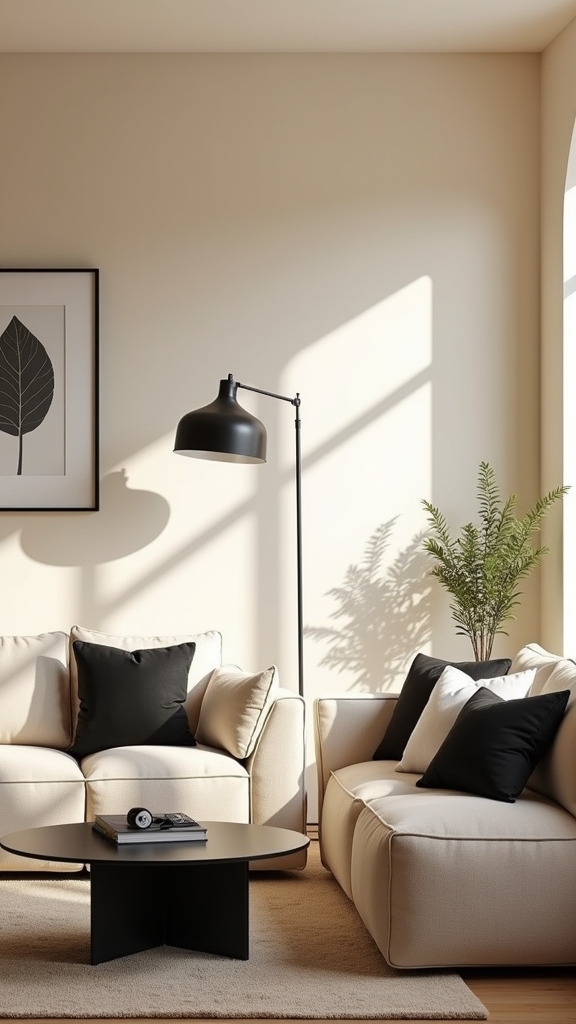
Contrast defines sophisticated interiors, and introducing black accents to beige living room walls exemplifies this principle.
Strategically placed black elements—such as matte metal fixtures, streamlined furniture, or minimalist picture frames—create a sophisticated contrast that enhances the beige living room’s elegance. The interplay between warm beige tones and crisp black details achieves a visually compelling balance, adding depth and architectural interest to the space.
For ideal impact, designers recommend concentrating black accents in focal points, like decorative pillows or sculptural lamps, to draw the eye and infuse graphic interest. This approach not only sharpens the room’s aesthetic but also facilitates the layering of textures and patterns.
Ultimately, integrating black accents into beige living room schemes results in a dynamic, curated environment with enduring visual appeal.
Use Warm Stone Finishes to Enhance Coziness
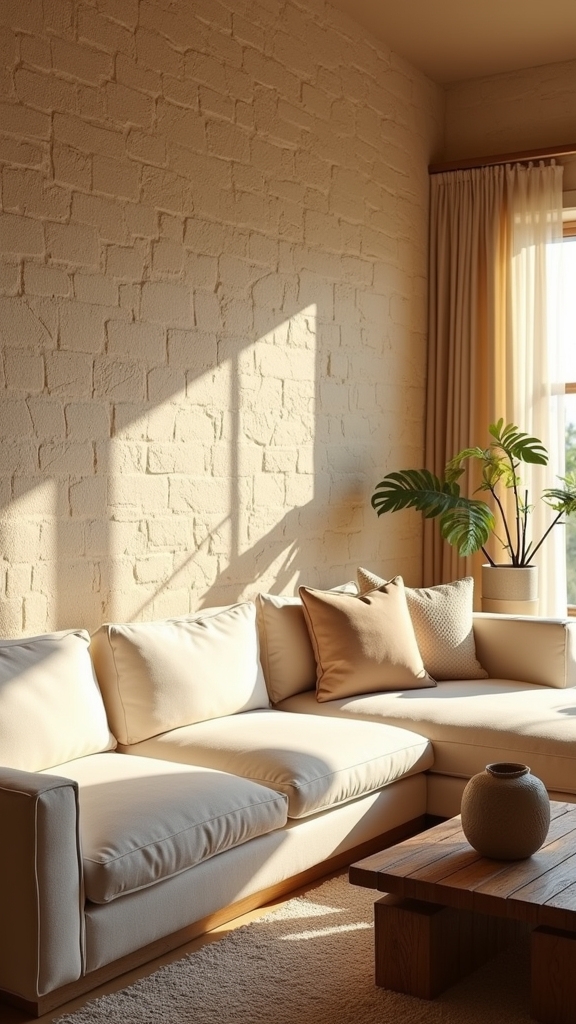
Incorporating warm stone finishes, such as a beige stone feature wall or fireplace, introduces organic texture and visual depth to the living room.
Pairing these natural surfaces with pale beige tile flooring and soft furnishings maintains a balanced, airy ambiance while amplifying warmth.
For added dimension, subtle blue accents can be integrated to offset the earth tones, achieving a cohesive and inviting space.
Embrace Natural Stone Textures
A beige stone fireplace wall commands attention as a central feature, infusing the living room with natural texture and visual depth. The utilization of natural stone textures introduces tactile interest, establishing a cozy atmosphere that feels rooted and timeless.
Warm stone finishes—ranging from subtle beige to muted gold—soften the overall aesthetic, ensuring the space remains inviting and harmonious. By integrating these elements, designers can bridge the gap between rustic comfort and contemporary elegance.
- Material Selection: Opt for stones with understated veining or gentle color variation to maintain a light, cohesive palette.
- Layering Textures: Pair stone walls with pale beige tile flooring to reinforce a seamless visual flow and amplify the room’s sense of airiness.
- Accent Integration: Introduce soft blue accents to enhance warmth and highlight the organic beauty of stone.
Balance Warmth With Light
Building on the tactile allure of natural stone, designers often select warm beige finishes to foster an inviting sense of coziness while maintaining a bright, open environment.
Warm stone walls, particularly when used as a fireplace surround, introduce both visual texture and a focal point that radiates warmth throughout the living room. To preserve the light, airy quality, pale beige tile flooring is recommended, amplifying natural illumination and complementing the stone’s hue.
Incorporating soft blue accents provides a subtle chromatic contrast, balancing the inherent warmth of the stone while supporting a serene, tranquil atmosphere.
The strategic use of warm stone finishes not only enhances the inviting nature of the space but also creates a seamless connection to the outdoors, reinforcing a relaxed, nature-inspired ambiance.
Mix Tones and Textiles for a Cozy Atmosphere
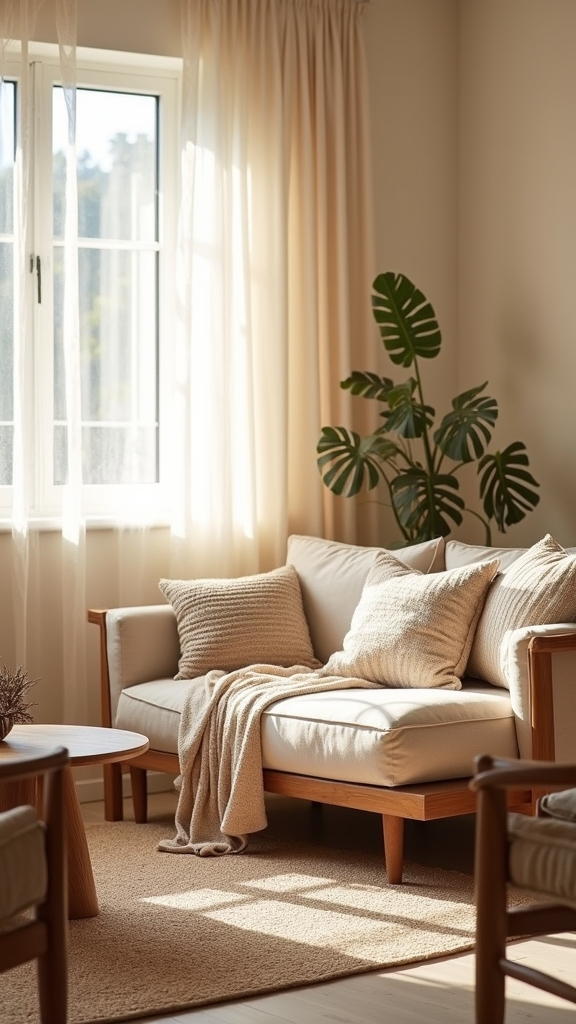
By blending a spectrum of beige tones—from subtle off-whites to earthy rusts—a living room achieves visual complexity and warmth.
Strategic use of varied hues avoids monotony and establishes a cozy atmosphere, while the thoughtful mix of tones and textiles enhances both tactile and visual interest.
Layering materials such as soft linens, plush velvets, and chunky knits not only contributes to depth but also evokes warmth and relaxation, making the space inherently inviting.
Scandinavian design principles, emphasizing simplicity and layered comfort, further enrich the effect.
For ideal results:
- Combine multiple beige shades across furnishings and accents to prevent flatness.
- Integrate diverse textiles—linen, velvet, and knit—for tactile richness.
- Layer throws and cushions to reinforce warmth and a homey, welcoming environment.
Keep It Minimalist With Pale Beige Walls
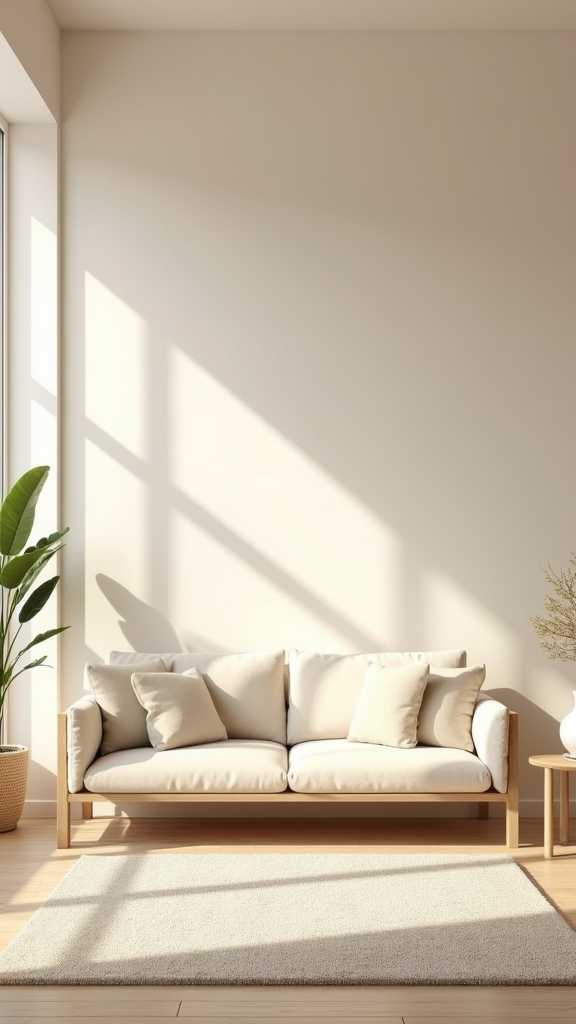
When employed as the primary wall color, pale beige establishes a tranquil foundation that amplifies the natural light and spatial clarity essential to minimalist living room design.
Pale beige walls create a light and airy setting, enhancing the perception of space and promoting relaxation. This subtle neutral acts as a versatile canvas, seamlessly accommodating minimalist decor and various accent colors without visual clutter.
The integration of smooth textures, curvy furniture silhouettes, and blond wood ceiling beams adds warmth and depth while maintaining the room’s understated elegance.
By favoring an uncluttered environment, pale beige walls support a peaceful daily living experience and foster a sense of calm.
For ideal effect, limit accessories and choose functional, sculptural pieces that complement the soft, inviting atmosphere characteristic of minimalist interiors.
Frequently Asked Questions
How Do You Brighten a Room With Beige Walls?
To brighten a room with beige walls, one should employ layered lighting options, select furniture choices in contrasting or vibrant hues, and integrate decorative accents with varied textures, ensuring visual dimension and maximizing ambient light for a luminous atmosphere.
What Colors Compliment Beige Walls?
Selecting soft accent colors such as muted blues or sage, integrating warm earthy tones like terracotta or olive, and incorporating vibrant artwork options enables designers to enrich beige walls, offering visual depth, warmth, and a dynamic, curated aesthetic.
How to Make a Beige Living Room Pop?
To make a beige living room pop, one should integrate vibrant artwork and bold beige accent pieces, utilize textured fabrics like velvet or linen for depth, and incorporate layered materials and statement decor for enhanced visual dynamism and contrast.
How to Make a Beige Room More Interesting?
To make a beige room more interesting, experts recommend introducing textured accents for tactile depth, employing layered lighting for visual dynamism, and showcasing vibrant artwork to create striking focal points that balance the neutral palette with compelling visual contrast.
Conclusion
In conclusion, beige living room walls offer remarkable versatility, serving as a refined backdrop for diverse design approaches. By incorporating texture, layering shades, and introducing contrasting accents, homeowners can create spaces that balance warmth and sophistication. Thoughtful integration of stone finishes, textiles, and minimalist palettes raises visual interest while maintaining a light, inviting atmosphere. Ultimately, these expert strategies guarantee that beige walls transcend neutrality, providing a dynamic foundation for both contemporary and timeless interiors.
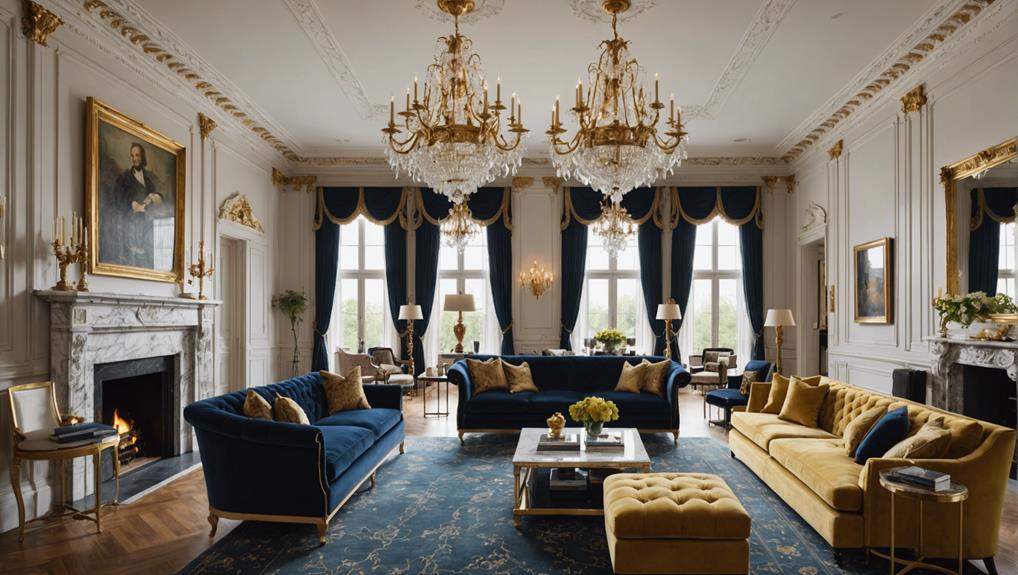
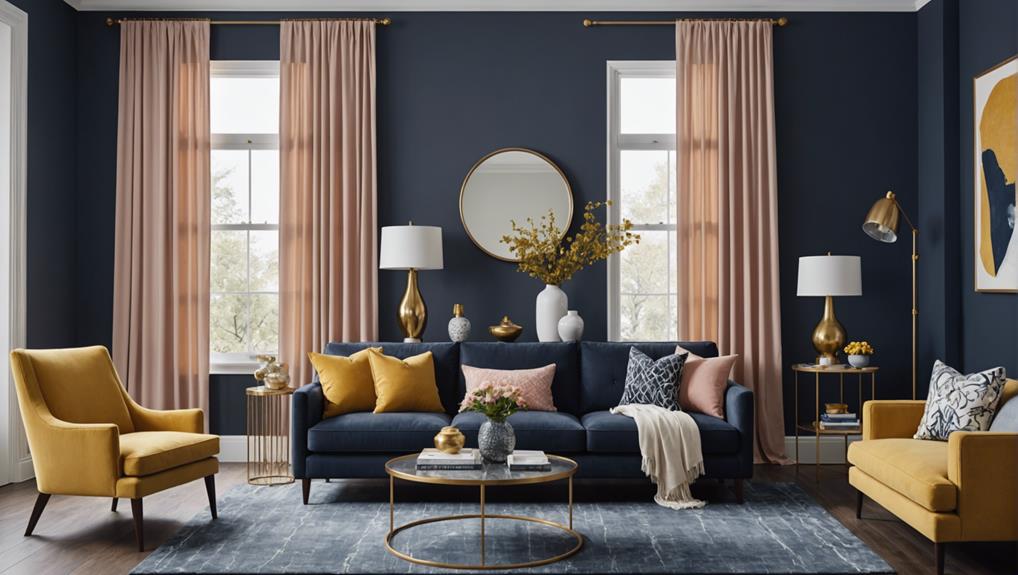
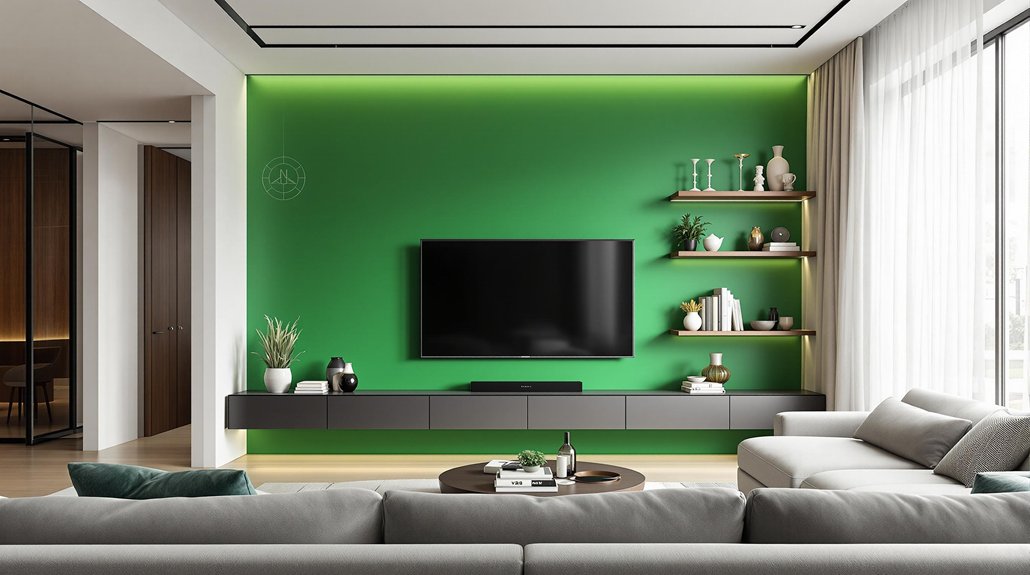
Leave a Reply